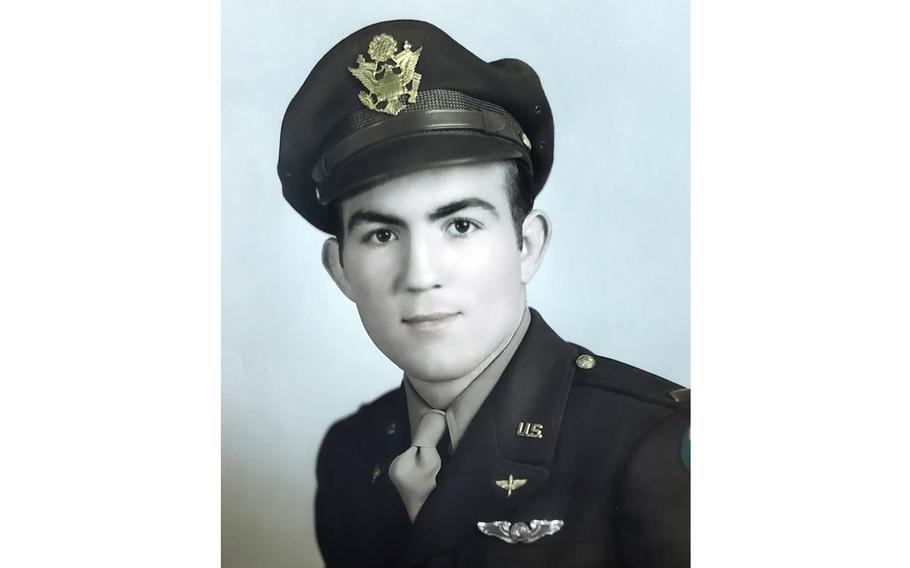
Army Air Forces 2nd Lt. Eugene Homyak, posing here in a photo taken during World War II, is believed to have died in the Tokyo Military Prison fire of May 1945. (Carol Monday)
Nearly 80 years after a devastating fire tore through a Japanese military prison during World War II, a Defense Department agency is working to identify American prisoners of war who died in the blaze.
Among those believed killed was 2nd Lt. Eugene Homyak, a 21-year-old radio operator from Denver. He was one of two survivors when his B-29 Superfortress bomber was shot down over Japan on March 10, 1945.
Homyak died weeks later, the Army told his family, at Tokyo Military Prison when it burned to the ground during a firebombing on May 25, 1945, killing dozens of American POWs interred there.
The military said Homyak’s remains were “not recoverable.”
Now, the Defense POW/MIA Accounting Agency, or DPAA, is trying to prove otherwise.
“Do we know exactly who died?” DPAA historian Aelwen Wetherby said in a March 14 phone interview. “I would say no. We have a lot of evidence, but any time we’re dealing with POWs, especially in circumstances like those surrounding the Tokyo Prison fire, it comes with a level of uncertainty.”
Burned records and broken links
The eldest of Homyak’s two daughters, Carol Monday, 82, said she has always believed her father died in the prison fire. She remembers seeing him once as a small child.
“It was agony,” she said by phone on March 18. “My grandmother and my mother, they were in agony trying to figure out what was happening.”
After the war, investigators compiled a list of 62 Americans believed to have died in the blaze. But that total was based largely on circumstantial evidence.
Sixteen names came from dog tags found at the prison site. Another 31 were provided by some of the roughly 400 Japanese inmates held alongside the Americans. The remaining 15 names came from interviews with surviving POWs who recalled seeing or hearing of others possibly transferred to Tokyo Military Prison but could not confirm their fates.
“The Japanese records burned when the prison burned, so we do not have a formal list from the Japanese of who the POWs were,” Alexander Christensen, the DPAA forensic anthropologist leading the effort, said by phone March 21.
A deepening investigation
After the fire, Japanese officials buried what they believed to be American remains in a bomb shelter trench. In 1950, those unidentified remains were reinterred as unknowns at Manila American Cemetery and Memorial in the Philippines.
Postwar investigators concluded the remains represented 64 individuals. Of those, 25 were identified through dental records – all U.S. Army Air Forces bomber crew members, Christensen said.
“These guys had much better documented dental work than many World War II casualties, certainly better than your standard Army infantryman,” he said.
In 2022, DPAA exhumed the remaining 39 sets for analysis at its lab in Hawaii. For the sake of thoroughness, the project has expanded the initial list from 62 names to 81 by including 19 additional bomber crew members who went missing over Japan and may have died in the fire.
“There’s no evidence that they were brought to the prison, but they could have been,” Christensen said.
The 39 sets of remains under analysis are so badly commingled and lack sufficient documentation that DNA is the only path to identification.
“There isn’t a single accession of that 39 that only has one person in it,” he said.
But DNA testing has been inconsistent. Some samples yield usable genetic sequences, while many do not — possibly due to varying soil conditions at the cemetery.
Success now depends largely on collecting DNA reference samples from relatives of the 81 men. As of February, DPAA had samples for 63 of them.
So far, two men have been identified.
Monday, her sister and a male cousin submitted DNA samples last year. She believes her father is among those being analyzed in the Hawaii lab.
“It’s exciting,” she said of the thought of his remains coming home. “And I think it’s exciting because it’s been kind of a blank spot, you know?”